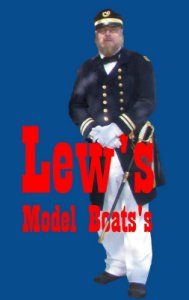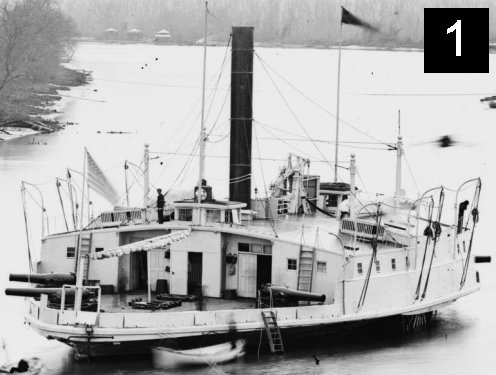
|
Welcome to - Lew's Model Boats - and more! |
go to Home Page |
| LewsModelBoats.org is not a commercial web site. Lew is a scale model builder/hobbiest (model boats and more). Views on this web site are opinions of the author and not driven by any commercial entity. Opinions are welcome - by mailing Lew (see contacts). © Copyright 2024 Lew's Model Boats. Disclosure: This Lews Model Boats do not have any financial ties to any company, political affiliation nor any other subsidy and has no gains from these and any other person(s). Lews Model Boats and this site is purely for the enjoyment of its viewers and others who enjoy this hobby. |
Section 1 - History
Twenty “double-ended” ferries were purchased in New York by the
Union Navy and ended up serving in various squadrons as gunboats.
They had the ability to navigate shallow water and
reverse direction without having to turn around.
Section 2 - Photos & Data
Section 3 - Research (the available information and sources)
Section 3A - Identifying the Photos and Drawings
Section 4 - Drawing (selection of a specific model and creating drawings)
Section 5 - Building (model construction)
Section 6 - Modeling the USS Fort Henry

This site looks at the few photographs that were taken of the "Ferry-Gunboats" and combined with the published data and drawings of the period, try to determine the correct names of the boats in the photos. Unfortunately, there are a lot of conflicts, even within the government sites such as the National Archives, U.S. Navy, etc.
The close-up photos offer more creditability in the correct ship's name as the photographer was on board to take the photo(s). However, the ones taken from the shoreline are in question. (Did the photographer say "Hey pal, what is the name of that boat out there, the one I am photographing?" Obviously, some made errors back then.) There were seven ex-NYC ferry-gunboats operating on the James and nearby rivers during the Civil War. This leaves room for error in naming the boats in the photos.
If you have any
information or images, or perhaps comments or corrections, please
contact me (see contacts on buttons, upper right).
Twenty New York ferryboats were purchased, not conscripted, by the U.S. Navy and served in almost every squadron, even as far away as Texas. The first ferry was sold to the Navy in September, 1861, and the last one in August, 1863. The displacement ranged from 226 tons (110 feet LWL) up to 892 tons (213 feet LWL). The price the Navy paid ranged from $19,000 to $100,000. Some of the ferries were taken out of service and sold to the Navy while a few were under construction and went directly from the builders yards to the Navy yards. Eleven of these gunboats retained the name given to them as ferries. Of the remaining nine, some were renamed, and the rest were new builds.
All of the “New York ferries” required additional work in order to serve as gunboats. They were often stripped of civilian amenities and modified for war service. The open ends of the “drive through” decks were enclosed to serve as quarters for the gunboat crew which was significantly larger than a normal ferry’s crew. Bulkheads were added around the perimeter of the double ends. Some of the bulkheads were sophisticated fold down barriers while others were simply sandbags. Naval guns were typically added to both ends. The small double-enders typically had twelve and twenty pounders. Many of the medium and larger gunboats had thirty-two pounders or larger guns, often in combination with 8-inch or 9-inch smooth bores. One gunboat mounted two 11-inch smooth bore guns.
These double-ended gunboats were assigned to various
divisions of the Union Navy, North Atlantic (NABS), South Atlantic
(SABS), West Gulf (WGBS), and East Gulf (EGBS) Blockading Squadrons.
Several were assigned to the Potomac Flotilla (PF, part of the NABS) and were
on station in the waters around Chesapeake Bay.
Five of these ferry-gunboats sailed down the east coast, around Key
West and up into the Gulf of Mexico to serve in the two squadrons
there.
The following names the twenty gunboats sorted by the squadron they
served in:
| North Atlantic Blockading Squadron | South Atlantic Blockading Squadron | |
| U.S.S. Commodore Barney |
U.S.S. Commodore McDonough | |
| U.S.S. Commodore Jones | U.S.S. Ellen | |
| U.S.S. Commodore Morris | ||
|
|
West Gulf Blockading Squadron | |
| U.S.S. Commodore Read | U.S.S. Clifton | |
| U.S.S. Commodore Hull | U.S.S. John P. Jackson | |
| U.S.S. Hunchback | U.S.S. Westfield | |
| U.S.S. Morse | ||
| U.S.S. Shokokon | East Gulf Blockading Squadron | |
| U.S.S. Southfield |
U.S.S. Fort Henry | |
| U.S.S. Stepping Stones |
U.S.S. Somerset | |
| U.S.S. Whitehall |
||
|
U.S.S. Wyandank |
Updated: April 30, 2011